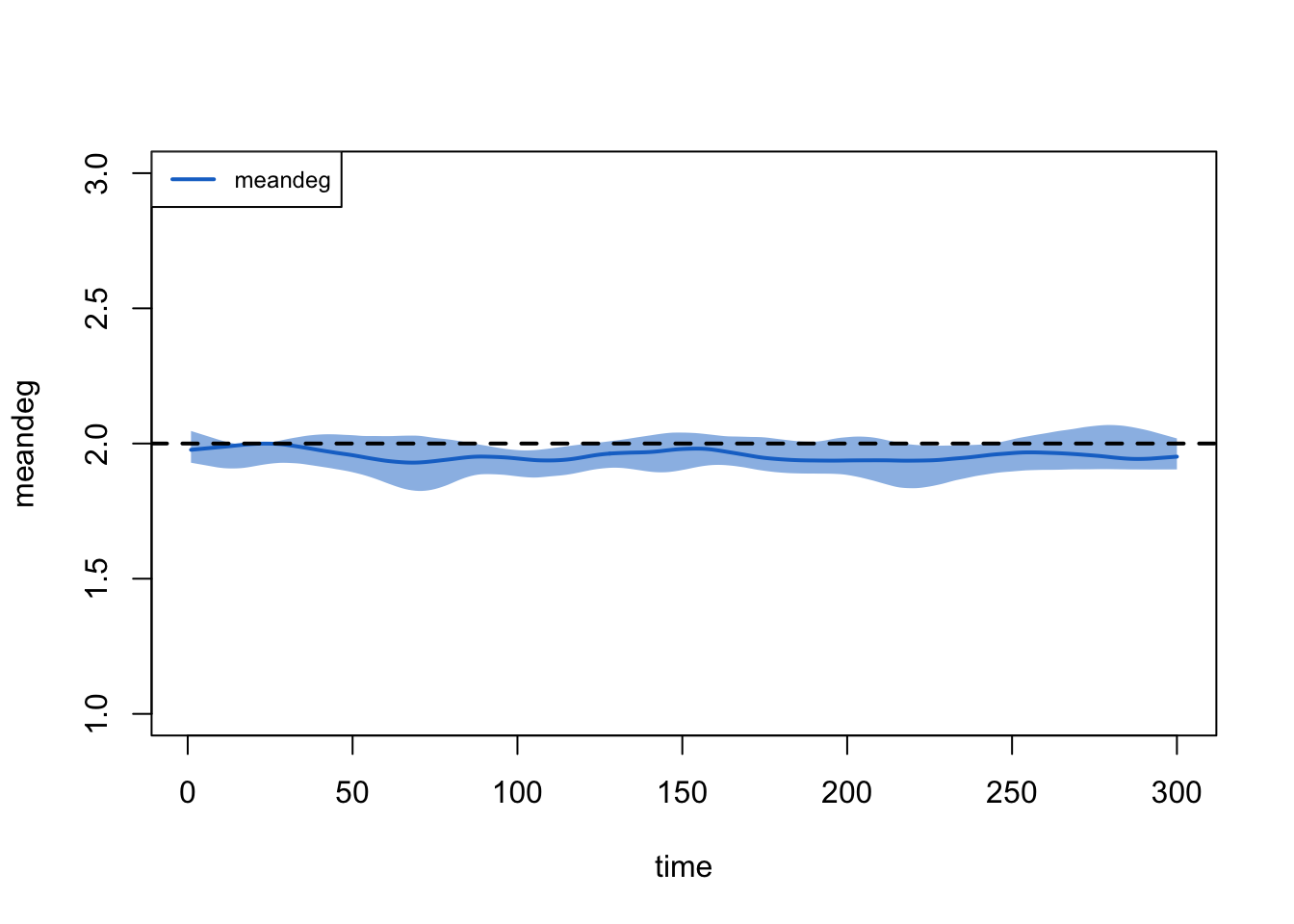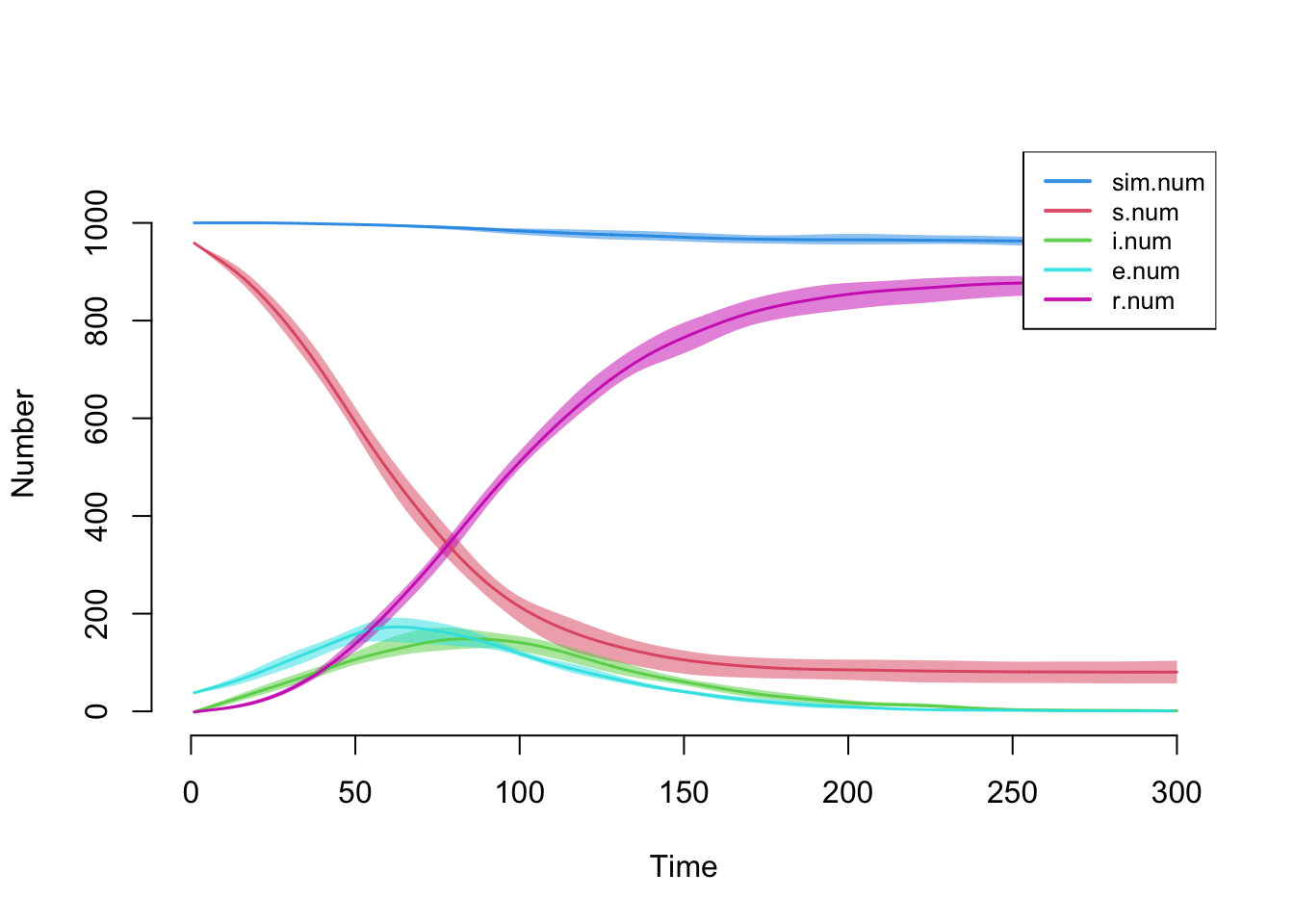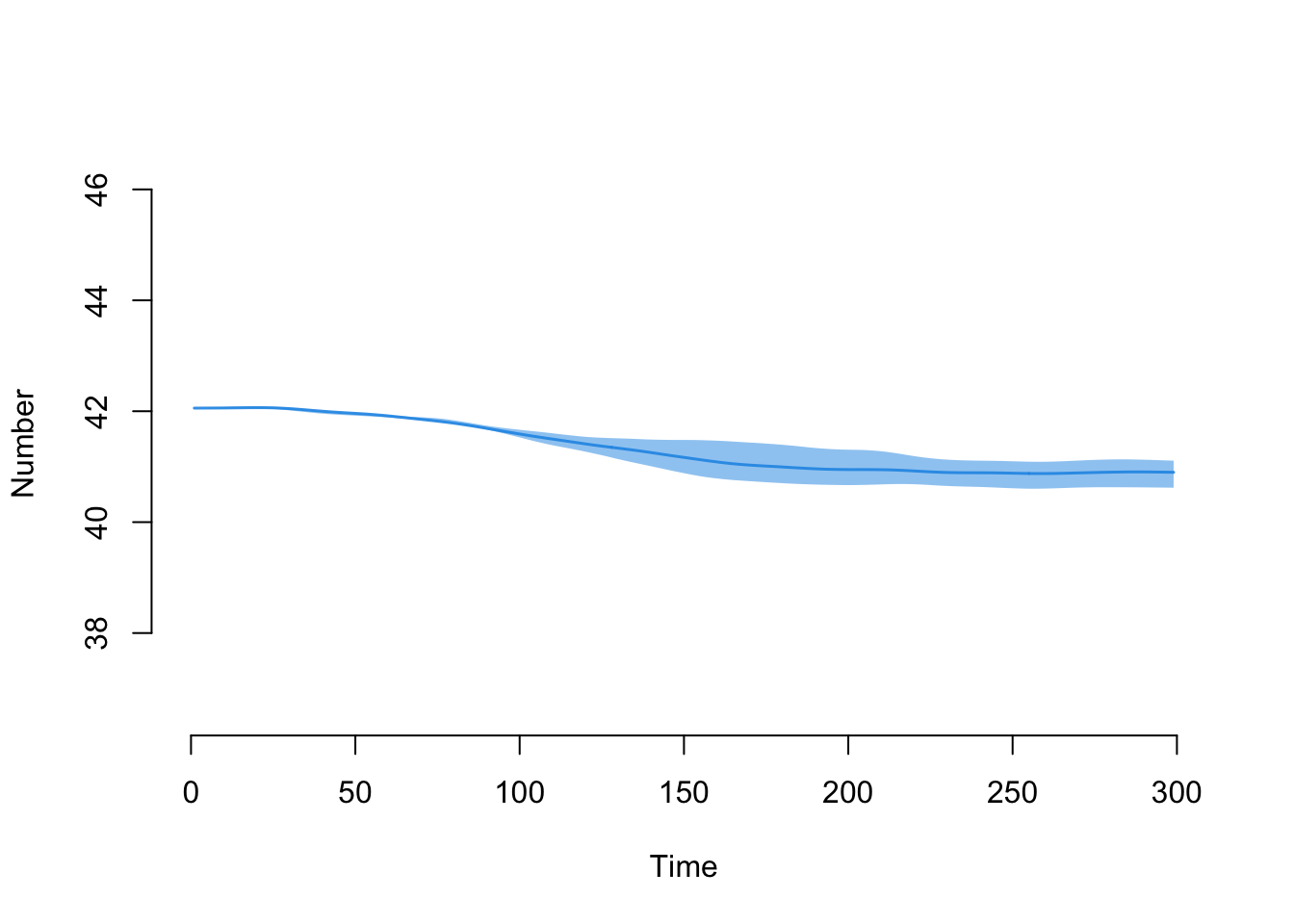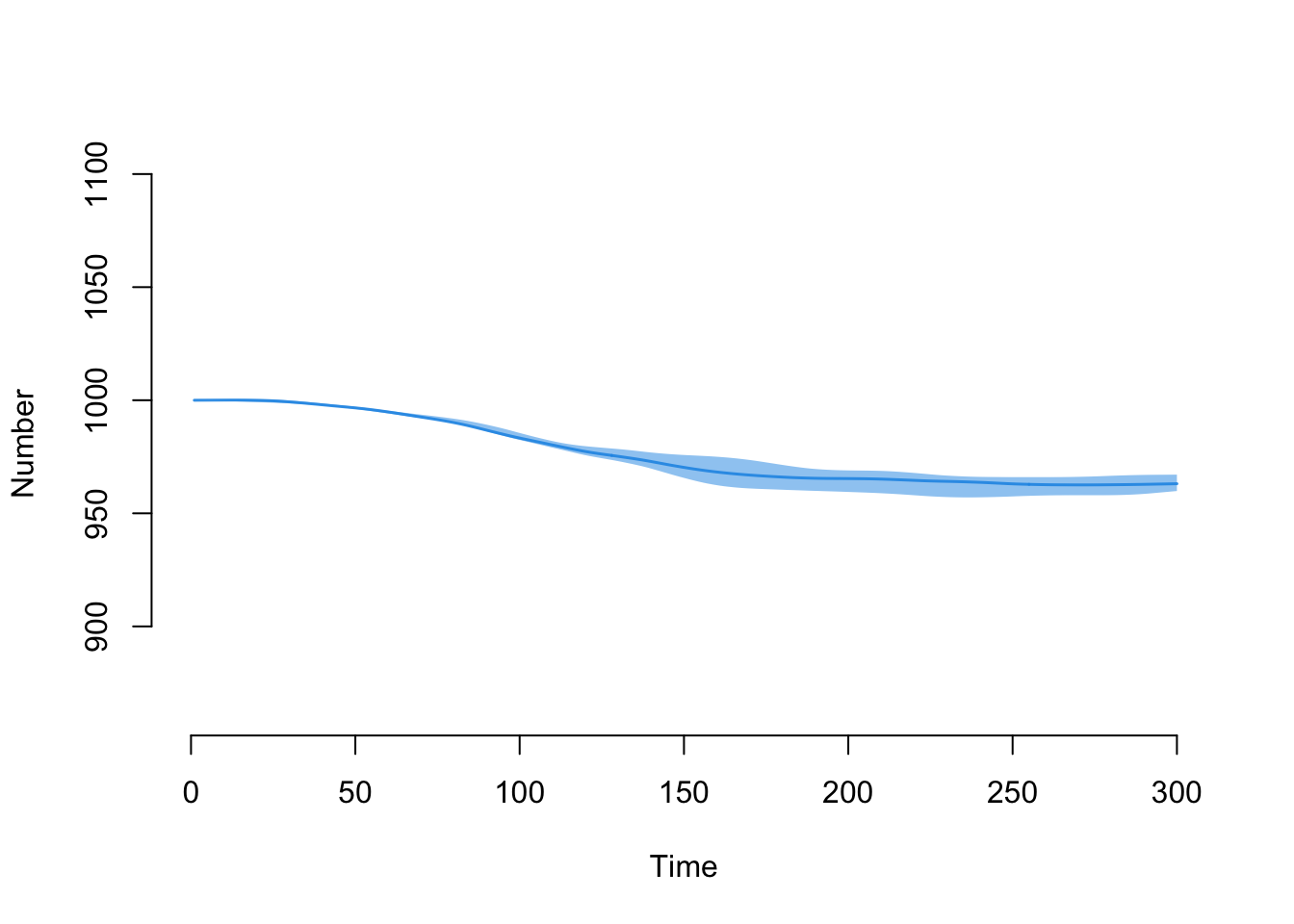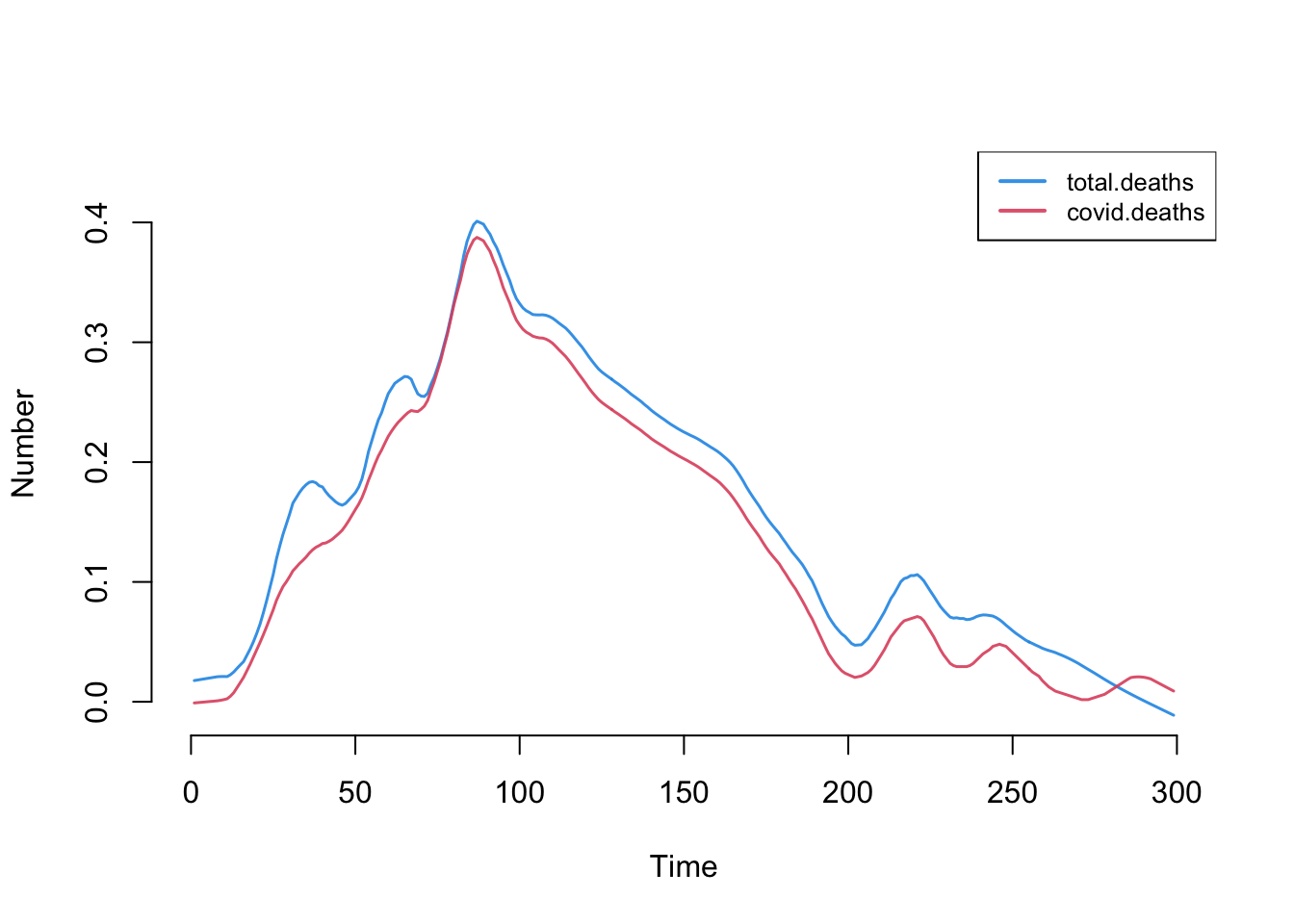38 Starting a COVID Model
In this tutorial, we will build on our SEIR model for COVID-19 by adding demography (aging, births, and deaths). This will involve learning a few new components of the EpiModel extension API.
This tutorial has two R scripts you should download: a primary script containing the code below and a separate module script. Download both and put them in the same working directory.
38.1 Setup
First start by loading EpiModel and clearing your global environment.
We will use the extension infection and disease progression modules from Day 4. Like the models with extension modules we ran then, we will keep the functions within one R script and the code to run the model in another script. For the purposes of this tutorial, we will show them bundled together but the linked files are split.
We will start with the initialization of the network object, with the relevant age and disease status attributes, then show the new epidemic models, then the network model estimation, and then epidemic model parameterization and simulation. In practice, we would typically go back and forth many times between all of these components.
38.2 Network Initialization
The model will represent age as a continuous nodal attribute. Aging will increment this attribute for everyone by a day (the value of the time step) in a linear fashion, and mortality will be a function of age.
To start, we initialize the range of possible ages (in years) at the outset.
Next, we calculate age-specific mortality rates based on one demographic table online. This lists the rates per year per 100,000 persons in the United States by age groups, in the following age bands:
Code
# Rates per 100,000 for age groups: <1, 1-4, 5-9, 10-14, 15-19, 20-24, 25-29,
# 30-34, 35-39, 40-44, 45-49, 50-54, 55-59,
# 60-64, 65-69, 70-74, 75-79, 80-84, 85+
departure_rate <- c(588.45, 24.8, 11.7, 14.55, 47.85, 88.2, 105.65, 127.2,
154.3, 206.5, 309.3, 495.1, 736.85, 1051.15, 1483.45,
2294.15, 3642.95, 6139.4, 13938.3)To convert this to a per-capita daily death rate, we divide by 365,000:
Next we build out a vector of daily death rates by repeating the rate above by the size of the age band. Now we have a rate for each age, with some repeats within age band.
Code
ages dr_vec
1 0 1.612192e-05
2 1 6.794521e-07
3 2 6.794521e-07
4 3 6.794521e-07
5 4 6.794521e-07
6 5 3.205479e-07
7 6 3.205479e-07
8 7 3.205479e-07
9 8 3.205479e-07
10 9 3.205479e-07
11 10 3.986301e-07
12 11 3.986301e-07
13 12 3.986301e-07
14 13 3.986301e-07
15 14 3.986301e-07
16 15 1.310959e-06
17 16 1.310959e-06
18 17 1.310959e-06
19 18 1.310959e-06
20 19 1.310959e-06It ends up looking like this visually:
Code
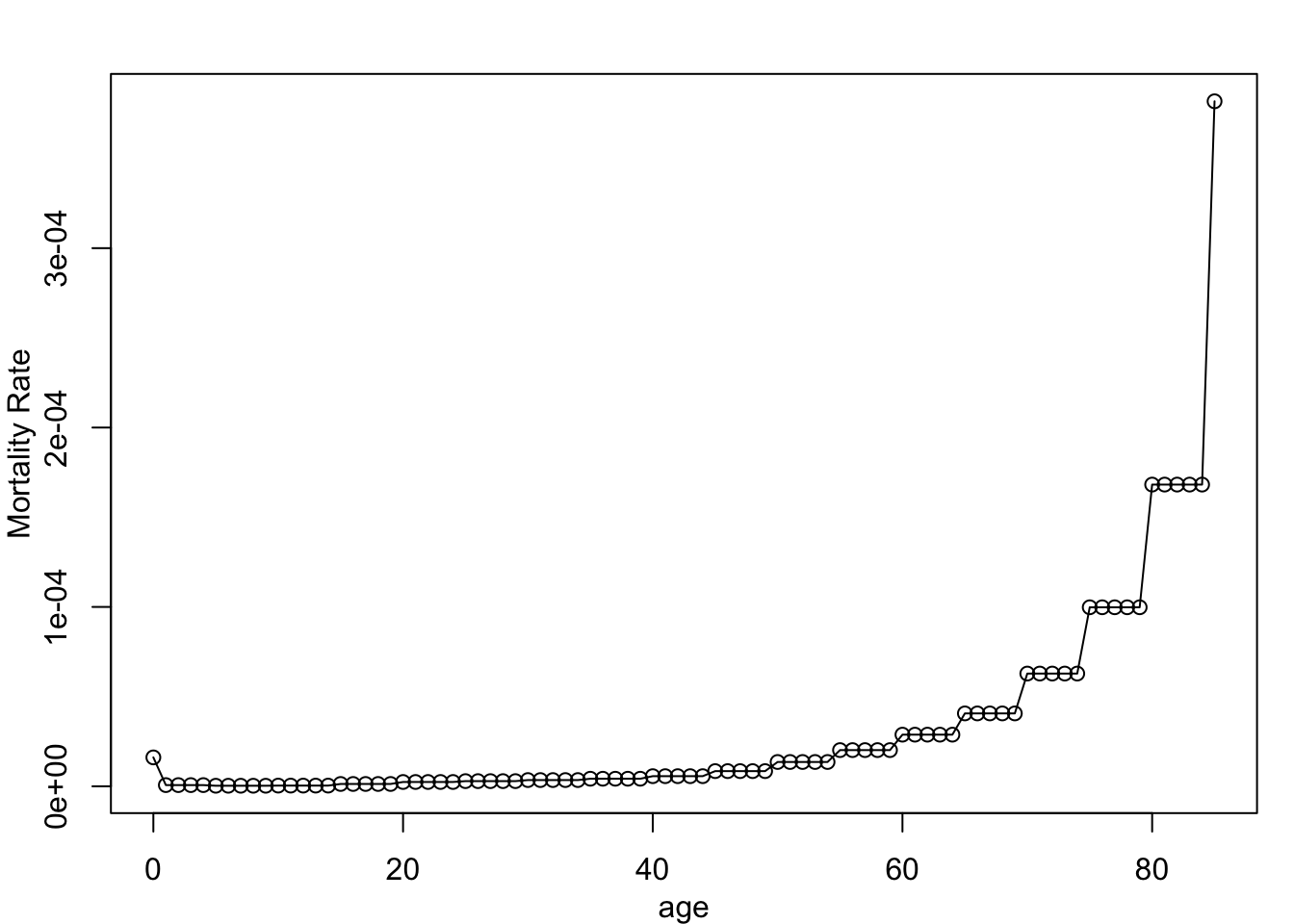
We will now add age and disease status attributes to an initialized network object. We will use a larger population size than last time:
For each node, we will randomly sample an age from the vector of ages (from 0 to 85), and then set that as a vertex attribute on the network object.
This model will also initialize people into a latent (E state) disease stage.
Code
statusVec
e s
50 950 [1] 8 22 36 56 71 76 101 111 158 223 265 343 362 364 379 404 414 428 430
[20] 440 441 491 493 531 560 574 576 584 599 618 646 673 674 718 742 760 770 805
[39] 814 826 833 842 843 845 856 882 886 927 929 939Because of that we will manually set up a vector of disease statuses and set it on the network object as a status attribute. This is an alternative way to set up disease status, instead of using the initial conditions in init.net.
38.3 Demographic Modules
With the network initialized, we will now turn to building out the three new extension modules. This set of extensions will add three demographic processes to the model: aging, births, and deaths. The birth and death processes in particular will involve some specific changes to the nodes that must be completed under the EpiModel extension API.
38.3.1 Aging
The aging module performs one simple process: to update the age attribute (in years) of everyone on the network by a day (or 1/365 years). It does this by getting the age attribute from the dat object, updating the vector, and then setting it back on the dat object. The function design follows the same format as our SEIR modules in Day 4.
We also add a new summary statistic, meanAge, which is the mean of the age vector for that time step.
38.3.2 Mortality
For the mortality module, we will implement a process of age-specific mortality with an excess risk of death with active infection. The process is more complex than the built-in departures module (which might cover death but other forms of exit from the population). We will step through the function together in the tutorial.
Note that the overall design of the function is similar to any other EpiModel extension module. The get_ and set_ functions are used to read and write to the dat object. The individual process of mortality involves querying the death rates by the age of active nodes, and then drawing from a binomial distribution for each eligible node.
EpiModel API Rule: For nodes who have died, two specific nodal attributes must be updated: active and exitTime. Upon death, the active value of those nodes turns from 1 to 0. The exitTime is the current time step, at. These two nodal attributes must be updated in a death (or other departure) module to tell EpiModel how to appropriately update the network object at the end of the time step (which you never have to worry about).
Code
dfunc <- function(dat, at) {
## Attributes
active <- get_attr(dat, "active")
exitTime <- get_attr(dat, "exitTime")
age <- get_attr(dat, "age")
status <- get_attr(dat, "status")
## Parameters
dep.rates <- get_param(dat, "departure.rates")
dep.dis.mult <- get_param(dat, "departure.disease.mult")
## Query alive
idsElig <- which(active == 1)
nElig <- length(idsElig)
## Initialize trackers
nDepts <- 0
idsDepts <- NULL
if (nElig > 0) {
## Calculate age-specific departure rates for each eligible node ##
## Everyone older than 85 gets the final mortality rate
whole_ages_of_elig <- pmin(ceiling(age[idsElig]), 86)
drates_of_elig <- dep.rates[whole_ages_of_elig]
## Multiply departure rates for diseased persons
idsElig.inf <- which(status[idsElig] == "i")
drates_of_elig[idsElig.inf] <- drates_of_elig[idsElig.inf] *
dep.dis.mult
## Simulate departure process
vecDepts <- which(rbinom(nElig, 1, drates_of_elig) == 1)
idsDepts <- idsElig[vecDepts]
nDepts <- length(idsDepts)
## Update nodal attributes
if (nDepts > 0) {
active[idsDepts] <- 0
exitTime[idsDepts] <- at
}
}
## Set updated attributes
dat <- set_attr(dat, "active", active)
dat <- set_attr(dat, "exitTime", exitTime)
## Summary statistics ##
dat <- set_epi(dat, "total.deaths", at, nDepts)
# covid deaths
covid.deaths <- length(intersect(idsDepts, which(status == "i")))
dat <- set_epi(dat, "covid.deaths", at, covid.deaths)
return(dat)
}Note that the overall process of mortality involves flipping a coin for each eligible person in the population, weighted by their age and disease status, and keeping track of who came up as heads (i.e., a 1). We end the function by saving two summary statistics that count the overall deaths and the COVID-related deaths separately.
38.3.3 Births
Finally, we add a new arrivals module to handle births (there may be other forms of arrivals such as in-migration that we would like to handle separately) but not in this model. In terms of the process, births is a simple function of the current population size times a fixed birth rate. This is stochastic at each time step by drawing an non-negative integer from a Poisson distribution.
EpiModel API Rule: If there are any births, then all the nodal attributes for incoming nodes must be specified. At a minimum, all EpiModel models must have these 5 attributes: active, status, infTime, entrTime, and exitTime. The append_core_attr function automatically handles the updating of the active, entrTime, and exitTime attributes, since these will be uniform across models. Users are responsible for updating status and infTime with the desired incoming values, using the append_attr function. Any other nodal attributes specific to your model, such as age in our current model, should also be appended using this approach. The append_attr function allows you to write those standard values to the end of the attribute vectors, where new nodes are “placed” in terms of their position on the vector. append_attr can either take a single value (repeated for all new arrivals) or a vector of values that may be unique for each arrival.
Code
afunc <- function(dat, at) {
## Parameters ##
n <- get_epi(dat, "num", at - 1)
a.rate <- get_param(dat, "arrival.rate")
## Process ##
nArrivalsExp <- n * a.rate
nArrivals <- rpois(1, nArrivalsExp)
# Update attributes
if (nArrivals > 0) {
dat <- append_core_attr(dat, at = at, n.new = nArrivals)
dat <- append_attr(dat, "status", "s", nArrivals)
dat <- append_attr(dat, "infTime", NA, nArrivals)
dat <- append_attr(dat, "age", 0, nArrivals)
}
## Summary statistics ##
dat <- set_epi(dat, "a.flow", at, nArrivals)
return(dat)
}We close the function by adding a summary statistic for the number of births.
38.4 Network Model Estimation
With the new modules defined, we can return to parameterizing the network model. Recall that we have initialized the network and set the age and status attributes on the network above.
Network attributes:
vertices = 1000
directed = FALSE
hyper = FALSE
loops = FALSE
multiple = FALSE
bipartite = FALSE
total edges= 0
missing edges= 0
non-missing edges= 0
Vertex attribute names:
age status vertex.names
No edge attributesNext we will parameterize the model starting with the same terms as our last SEIR model, but adding an absdiff term for age. This will control the average absolute difference in ages between any two nodes. With a small target statistic, this will allow for continuous age homophily (assortative mixing).
For target statistics, we will start with mean degree, transform that to the expected edges, and then calculate the number of isolates (a synonym for degree(0)) as a proportion of nodes, and absdiff as a function of edges (the target statistic is the sum of all absolute differences in age across all edges, so this is the mean difference times the number of edges).
Code
[1] 1000 80 2000The dissolution model will use a standard homogeneous dissolution rate, with a death correction here based on the average death rate across the population and a multiplier to account for higher mortality due to COVID. This is not perfect, but this parameter is quite robust to misspecification because the huge differential in average relational duration versus average lifespan (1/mortality rates); notice the minimal change in coefficient with this adjustment.
Dissolution Coefficients
=======================
Dissolution Model: ~offset(edges)
Target Statistics: 20
Crude Coefficient: 2.944439
Mortality/Exit Rate: 6.31841e-05
Adjusted Coefficient: 2.946969Next we fit the model. You can ignore any warning messages about fitted probabilities that were 0 or 1. These are standard GLM fitting messages. If there is a problem in the model fit, it will emerge in the diagnostics.
We will run the model diagnostics by monitoring both the terms in the model formula and an extension of the degree terms out to degree of 6. We are using an MCMC control setting here to tweak the simulation algorithm to increase the “burn-in” for the Markov chain; this burn-in control is especially helpful in cases of ERGM formulas with absdiff terms (i.e., those with continuous attributes). Although the fit is not perfect here (we are on the cusp of where we also might want to turn off the edges dissolution approximation with edapprox), it is close enough to move forward for this tutorial.
Code
Network Diagnostics
-----------------------
- Simulating 10 networks
- Calculating formation statisticsEpiModel Network Diagnostics
=======================
Diagnostic Method: Dynamic
Simulations: 10
Time Steps per Sim: 500
Formation Diagnostics
-----------------------
Target Sim Mean Pct Diff Sim SE Z Score SD(Sim Means) SD(Statistic)
edges 1000 984.581 -1.542 1.801 -8.561 8.179 26.652
absdiff.age 2000 1971.994 -1.400 6.047 -4.631 29.132 83.189
degree0 80 89.366 11.707 0.431 21.713 1.723 9.904
degree1 NA 324.008 NA 0.781 NA 3.510 16.145
degree2 NA 290.750 NA 0.577 NA 1.767 14.761
degree3 NA 175.823 NA 0.488 NA 2.249 12.477
degree4 NA 79.398 NA 0.370 NA 1.748 9.069
degree5 NA 28.922 NA 0.225 NA 1.174 5.737
degree6 NA 8.909 NA 0.125 NA 0.486 3.165
Duration Diagnostics
-----------------------
Target Sim Mean Pct Diff Sim SE Z Score SD(Sim Means) SD(Statistic)
edges 20 19.993 -0.034 0.046 -0.151 0.175 0.603
Dissolution Diagnostics
-----------------------
Target Sim Mean Pct Diff Sim SE Z Score SD(Sim Means) SD(Statistic)
edges 0.05 0.05 0.018 0 0.089 0 0.007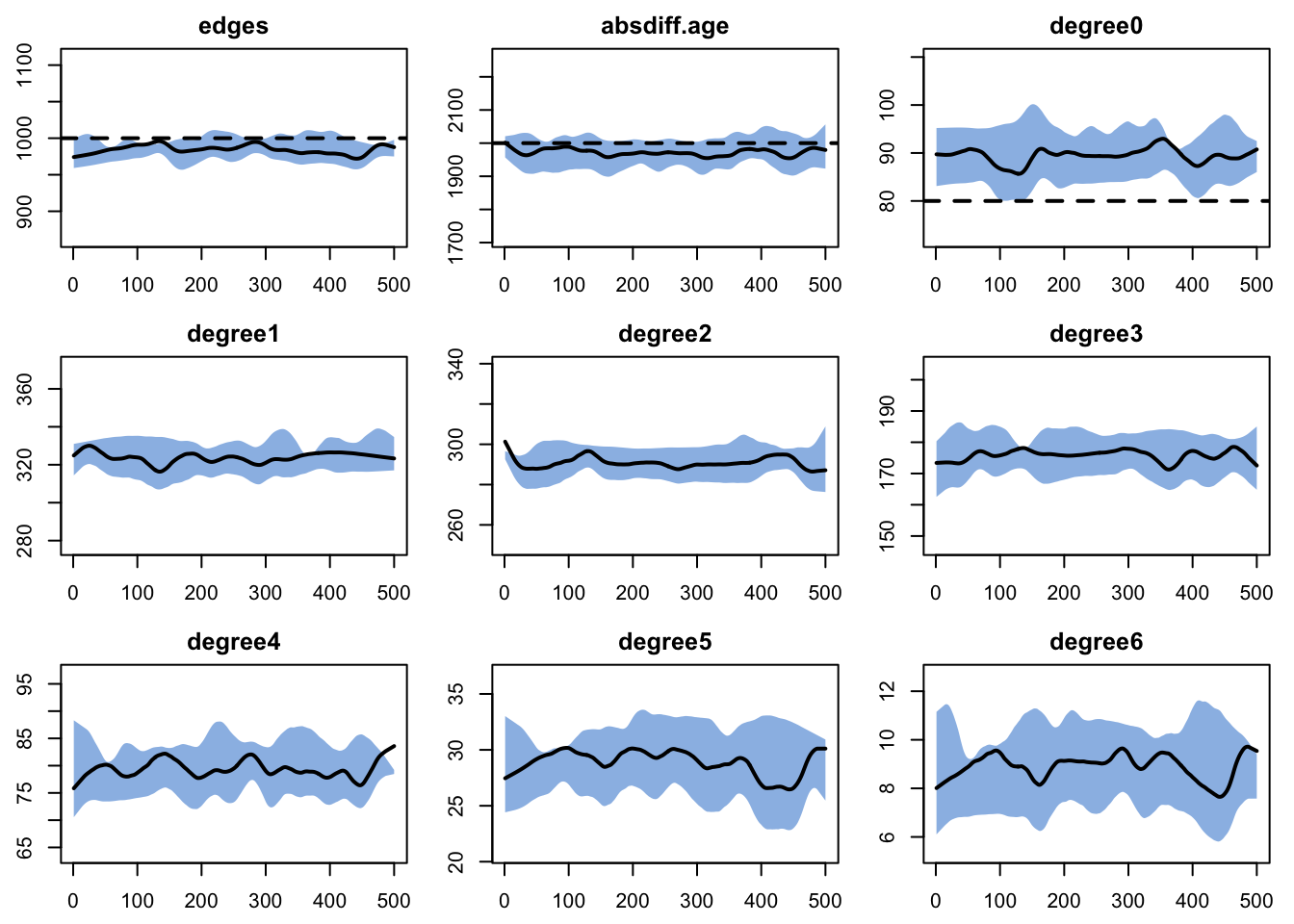
38.5 EpiModel Model Simulation
To parameterize the model, we need to add the newly referenced model parameters to param.net. These include the departure and arrival rates. Although our past parameters have been scalars (single values), there is nothing to prevent us from passing vectors (or even more structured objects like lists or data frames) as parameters. That is what we do with departure.rates. The departure.disease.mult is the multiplier on the base death rate for persons with active infection (persons in the “i” status). We will assume the arrival rate reflects the average lifespan in days.
For initial conditions, we have passed in the number initially in the latent state at the outset, so init.net just needs to be a placeholder input.
Finally, for control settings, we first source in the new function script (this should now contain five extension functions), and include module names and associated functions for each of the five. Note that these five modules will run in addition to the standard modules that handle initialization, network resimulation, and so on. For this model, we definitely want to resimulate the network at each time step, and we will use tergmLite for computational efficiency. We again use a burn-in control setting for TERGM simulations here, plus add some additional network statistics to monitor for diagnostics.
Code
source("mod9-COVID1-fx.R")
control <- control.net(type = NULL,
nsims = 5,
ncores = 5,
nsteps = 300,
infection.FUN = infect,
progress.FUN = progress,
aging.FUN = aging,
departures.FUN = dfunc,
arrivals.FUN = afunc,
resimulate.network = TRUE,
tergmLite = TRUE,
set.control.tergm = control.simulate.formula.tergm(MCMC.burnin.min = 10000),
nwstats.formula = ~edges + meandeg + degree(0:2) + absdiff("age"))With all that complete, we now are ready to run netsim. This should take a minute.
38.6 Post-Simulation Diagnostics
We run the network diagnostics with the netsim simulations complete to evaluate the potential impact of the epidemic processes on the network diagnostics. Here we see that the three targeted statistics are not maintained at their target levels. Part of this may be due to the general bias in the fit introduced by the edges dissolution approximation, highlighted in the netdx diagnostics above. But the change to the edges and absdiff statistics may be concerning.
Code
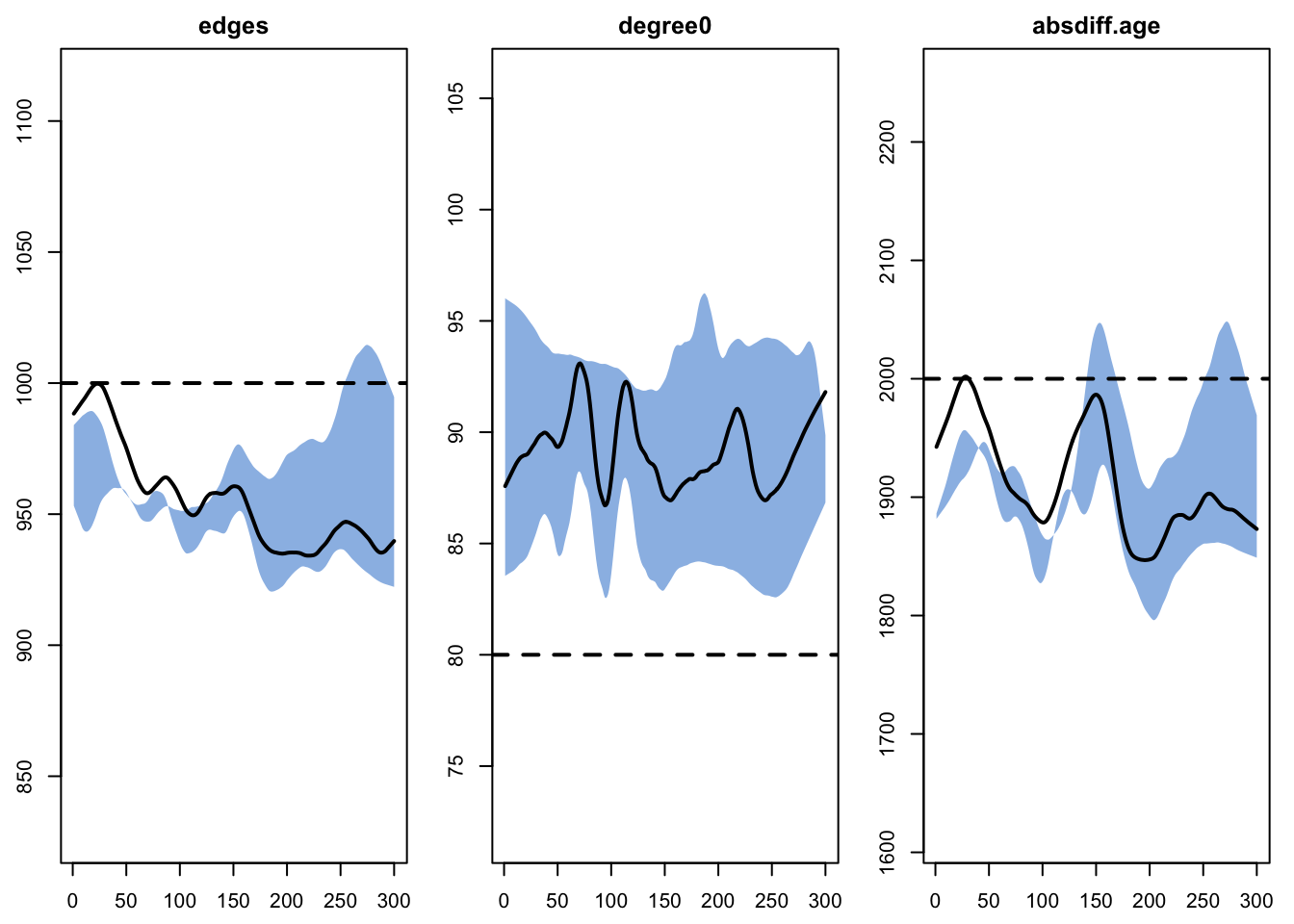
However, it is important to note that the change in edges may be related to underlying reductions in the population size (as a function of relatively high COVID-related mortality). To demonstrate this, we examine the meandeg statistics, which is the per capita mean degree (i.e., it does not depend on the fluctuations in population size). Here, the target statistic is relatively stable (perhaps a minor bias but nothing that will influence the epi outcomes too much).
38.7 Epidemic Model Analysis
With the epidemic model simulation complete, let’s inspect the network object. We can see a listing of the modules used, and the model output variables available for inspection. Because we used tergmLite, we only have the summary statistic data and not the individual-level network data.
EpiModel Simulation
=======================
Model class: netsim
Simulation Summary
-----------------------
Model type:
No. simulations: 5
No. time steps: 300
No. NW groups: 1
Fixed Parameters
---------------------------
inf.prob = 0.1
act.rate = 3
departure.rates = 1.612192e-05 6.794521e-07 6.794521e-07 6.794521e-07
6.794521e-07 3.205479e-07 3.205479e-07 3.205479e-07 3.205479e-07 3.205479e-07
...
departure.disease.mult = 100
arrival.rate = 3.223207e-05
ei.rate = 0.05
ir.rate = 0.05
groups = 1
Model Functions
-----------------------
initialize.FUN
resim_nets.FUN
summary_nets.FUN
infection.FUN
departures.FUN
arrivals.FUN
nwupdate.FUN
prevalence.FUN
verbose.FUN
progress.FUN
aging.FUN
Model Output
-----------------------
Variables: sim.num s.num i.num num ei.flow ir.flow e.num
r.num meanAge se.flow total.deaths covid.deaths a.flow
Networks: sim1 ... sim5
Transmissions: sim1 ... sim5
Formation Statistics
-----------------------
Target Sim Mean Pct Diff Sim SE Z Score SD(Sim Means) SD(Statistic)
edges 1000 955.367 -4.463 4.647 -9.605 11.640 32.257
meandeg NA 1.956 NA 0.006 NA 0.018 0.054
degree0 80 89.133 11.416 0.665 13.737 0.765 9.248
degree1 NA 317.397 NA 1.411 NA 3.402 15.887
degree2 NA 284.684 NA 1.009 NA 2.422 14.882
absdiff.age 2000 1913.539 -4.323 13.202 -6.549 20.635 88.391
Duration and Dissolution Statistics
-----------------------
Not available when:
- `control$tergmLite == TRUE`
- `control$save.network == FALSE`
- `control$save.diss.stats == FALSE`
- dissolution formula is not `~ offset(edges)`
- `keep.diss.stats == FALSE` (if merging)Here is a default plot of all the compartment sizes (all variables ending in .num), with the full quantile range set to 1.
Here is the disease incidence, plotted in two ways:
Code
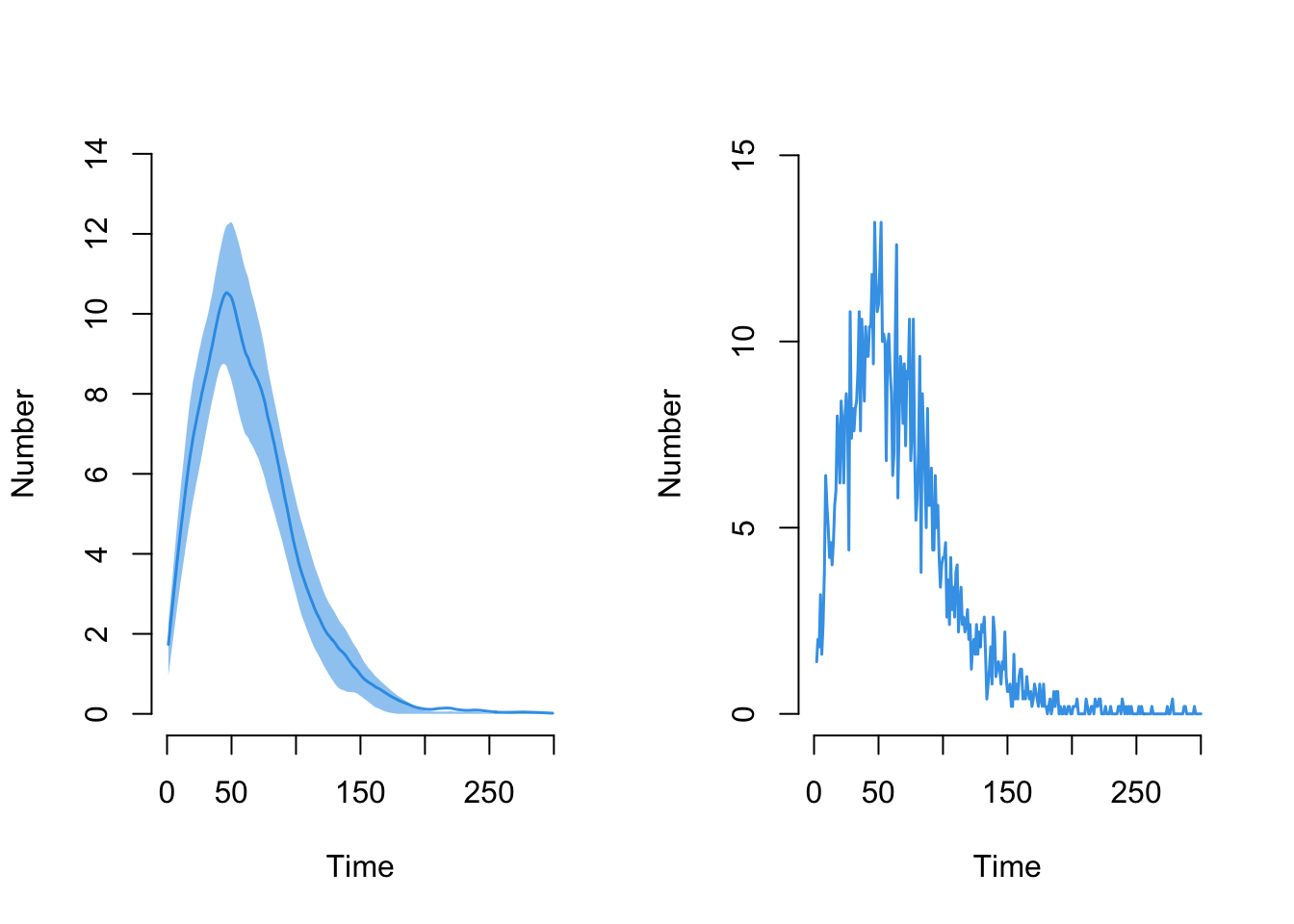
Here is the new mean age summary statistic.
Let’s export the data into a data frame that averaged across the simulations and look at the starting and ending numerical values for mean age:
[1] NaN 42.05174 42.05448 42.05722 42.05996 42.06270[1] 40.90025 40.90299 40.89722 40.89149 40.89423 40.89696Here is the decline in the overall population size over time:
This plot shows the number of new total and COVID-related deaths each day.
To demonstrate the transmission tree output for this extension model, we can extract the transmission matrix and then plot a phylogram:
# A tibble: 20 × 6
# Groups: at, sus [20]
at sus inf transProb actRate finalProb
<dbl> <int> <int> <dbl> <dbl> <dbl>
1 2 149 8 0.1 3 0.271
2 2 511 491 0.1 3 0.271
3 2 707 8 0.1 3 0.271
4 3 45 646 0.1 3 0.271
5 3 853 8 0.1 3 0.271
6 4 338 36 0.1 3 0.271
7 4 727 842 0.1 3 0.271
8 4 863 646 0.1 3 0.271
9 5 419 618 0.1 3 0.271
10 5 508 727 0.1 3 0.271
11 5 617 576 0.1 3 0.271
12 5 671 491 0.1 3 0.271
13 5 697 618 0.1 3 0.271
14 5 715 727 0.1 3 0.271
15 5 923 618 0.1 3 0.271
16 6 145 149 0.1 3 0.271
17 7 202 56 0.1 3 0.271
18 7 319 574 0.1 3 0.271
19 7 765 158 0.1 3 0.271
20 8 73 223 0.1 3 0.271found multiple trees, returning a list of 42phylo objects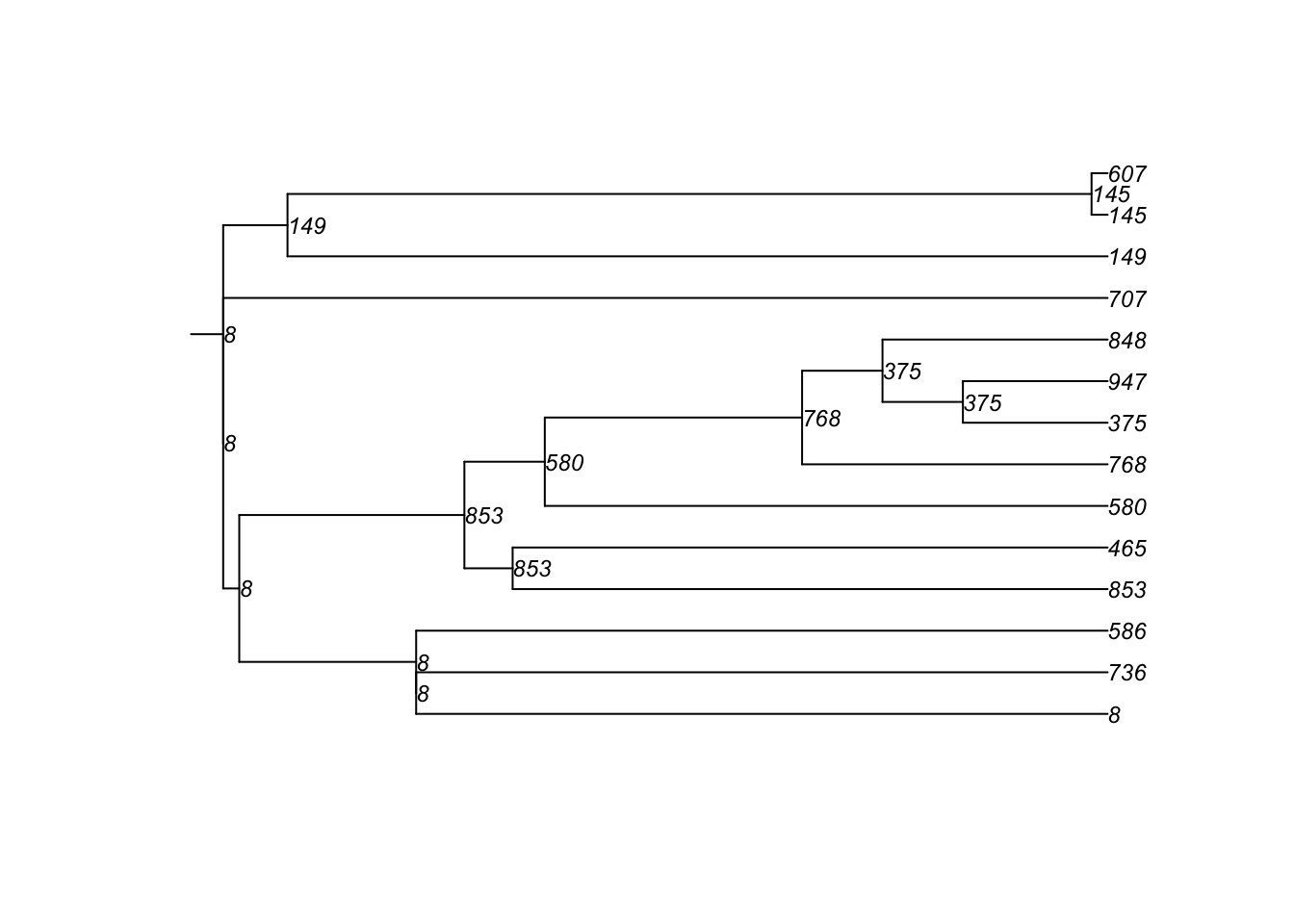
Overall, it appears that our new demographic features of the model are performing well!

